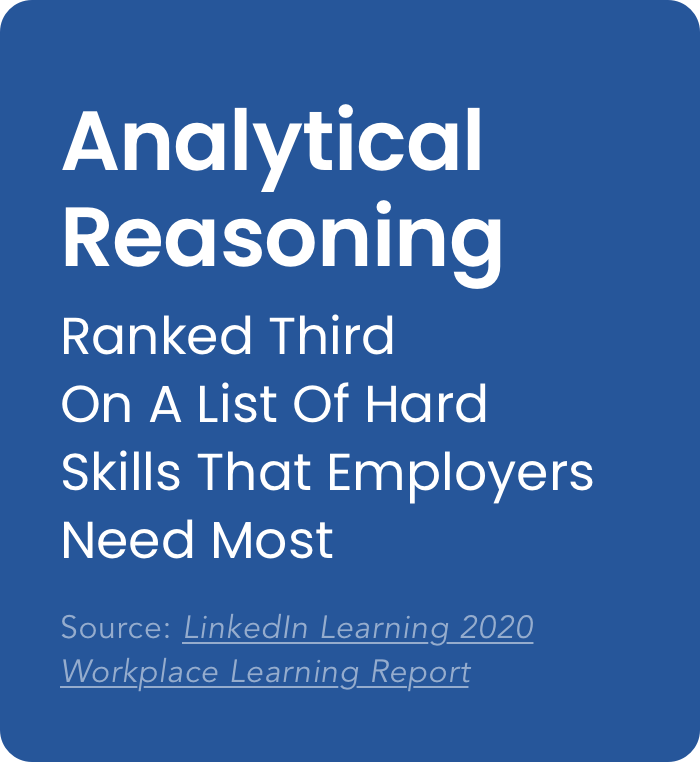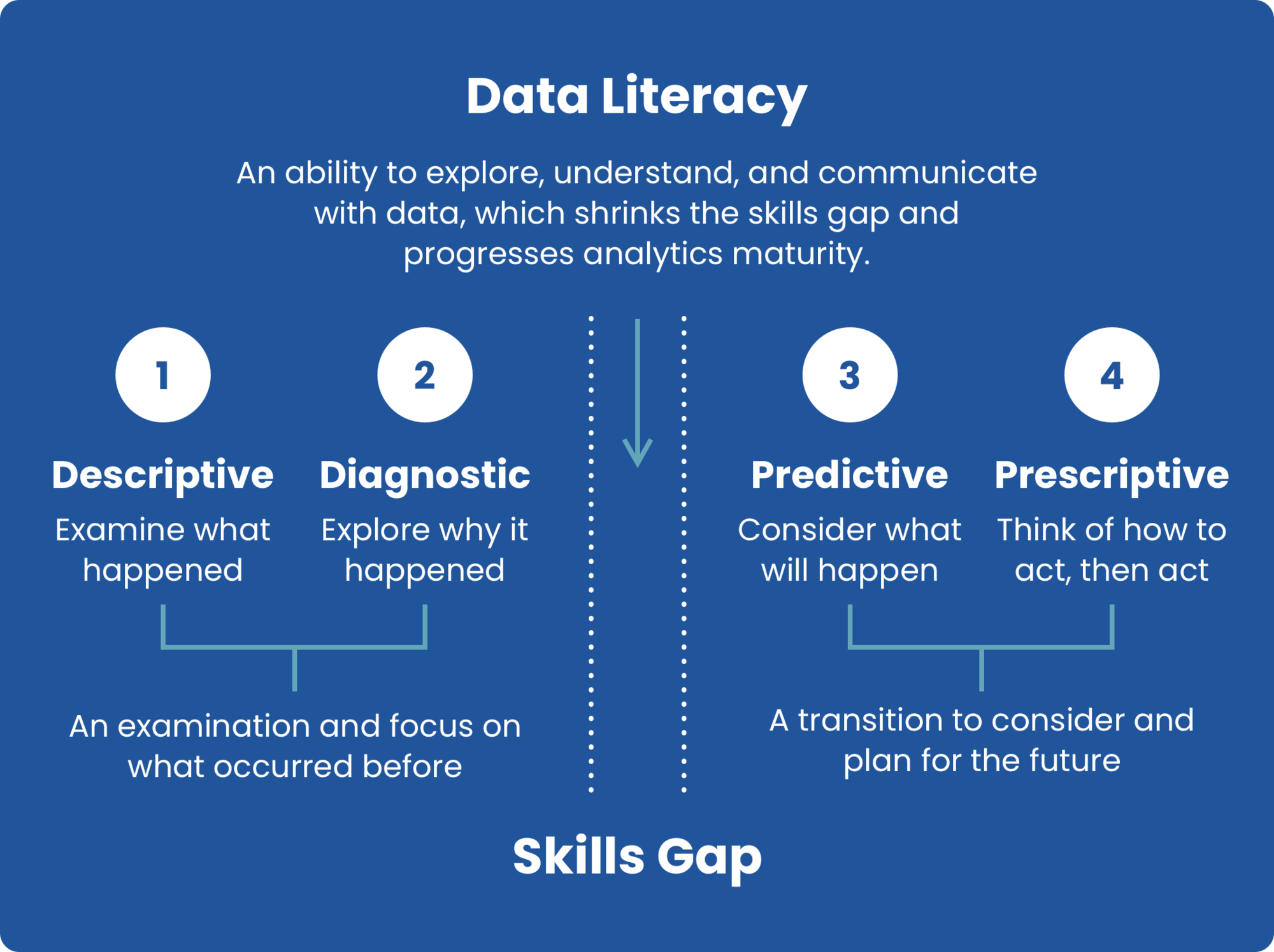A successful path to data literacy and analytics maturity for all
Editor's note: This article originally appeared in Forbes, by Sarah Nell-Rodriquez, Senior Manager of Customer Success, Tableau
Keeping up with rapid technology advancements and maintaining relevant skills has never been more difficult. Since the pandemic hit in early 2020, organizations have doubled down on digitization, data, innovation, and technology investments to equip their people with the skills and resources needed to succeed in uncertain, fast-paced times. For business leaders, this meant an organizational shift toward more data-driven jobs and a heightened focus on data skills—a transition that revealed the widespread lack of data skills and data literacy.
There's a crying need for people with data skills as digitization takes over every part of our life. But there's a huge gap: 83% of leaders say they want their organizations to be data-led, but only 33% of employees say they're comfortable working with data.
Once meant for data scientists and analysts, data literacy is now a requirement for all—from business leaders to front-line workers. To help shrink the data skills gap, here is some useful, tested guidance to help leaders evolve their organization’s analytics maturity and prioritize data literacy. In doing so, they can achieve a more data-literate workforce, with programming and resources to support analytics at scale so that everyone realizes value from data.

A closer look at analytics maturity
Before we share guidance that puts you on a clear path to achieving a data-literate workforce, you may find it helpful to understand the evolution of analytics maturity and where data literacy fits.

Data literacy plays an important role in each organization’s evolution to analytics maturity, shrinking the data skills gap and creating more data-literate workforces.
Organizations operate in each of the four levels of analytics maturity and use data differently. While not sequential, each maturity level must be addressed as a business follows its unique path, at its own pace, to develop a data-literate workforce. As noted, data literacy fits where the skills gap is most pronounced right now, between the descriptive and diagnostic phases (where many organizations are) to the predictive and prescriptive phases (where successful, data-driven organizations sit).
Shrinking the skills gap and transitioning to analytics maturity won’t happen overnight, but it’s time to start. Take simple steps first and bring data champions within your organization together to help light a fire. They’ll help build excitement, create quick wins, and demonstrate that anyone who’s data literate can support innovation, growth, and resilience. Then what?
A holistic approach to data literacy and analytics maturity
Wherever you are along the analytics maturity path, today’s workforce includes digital and non-digital natives. This dynamic creates some challenges and nuances when developing your data literacy program and building out key tactics within the context of analytics maturity.
To account for these nuances and challenges while closing the skills gap, encourage participation by all. This four-step action plan suggests areas of leadership support, training, measurement, and infrastructure as well as related tactics to improve data literacy.
These complementary measures will also help you as business leaders progress analytics maturity to achieve a thriving Data Culture:
- Have empathy: Knowing where data flows and how it’s consumed requires data empathy, which can be gained by asking questions. For example: Do our data sources serve the business needs? Do people have the proper context to interpret data? Are the analytics tools we use helping people perform better? Are dashboards giving users what they need?
- Prioritize data literacy: It’s critical as leaders to create and prioritize time and space for people to participate in training, projects, and infrastructure work. Equally important, is walking the walk, focusing time and attention on your own data literacy. When you understand the importance of data, and use it daily, you’ll become a better data leader and create a stronger Data Culture.
Nate Mayfield, vice president at Oracle and a contributing author of the Data Leadership Collaborative, says, "It’s my responsibility (and that of my other leaders) to ensure team members understand the impact their work has, which develops a sense of collective pride that we're all making a difference." - Target the right data skills and talent: As organizations evolve in analytics maturity, certain job roles and data skills are needed. Hiring the right talent is a priority. 2020 saw an increased demand for data scientists and analysts, yet 250,000 data science and analytics roles went unfilled—demand exceeded supply. You need clear job descriptions that prioritize data skills to find, attract, and match talent with business needs.
- Enable skills development: You can't measure and celebrate data literacy success without tracking it and investing in education—now and long-term.
a. There are third-party learning management systems (LMS) you can use, such as Skilljar and TalentLMS, that facilitate, manage, and measure the impact of data literacy training on the business.
b. On-the-job training bridges knowledge gaps and relieves learning pain points. Try third-party programs such as Coursera, edX, and Degreed to supplement internal education efforts and direct employees to also try free, self-guided data trainings.
c. For leaders overseeing learning and development, recognize and reward employees who show interest and learn new, high-demand skills and support others’ development. - Build community: It’s the foundation of any thriving Data Culture. When businesses value data literacy, they create ways to engage and immerse people in the language of data. You can foster community by:
a. Joining the Tableau Community to make powerful connections and take your data skills to the next level.
b. Creating your own community that enhances data knowledge, builds skills, and fosters connection and collaboration.
Data literacy in action
Industries from healthcare and finance to manufacturing and retail, are moving along the analytics maturity spectrum. Sports, especially, is using data to measure performance, evolve athlete development and training, and innovate in the field of play.
Across different industries, we’ve seen how Tableau customers such as Bank Mandiri, Cardinal Health, JLL, the Seattle Seahawks, and Swiss Life weigh the risks (financial loss, retention, hiring) of ignoring data literacy with the rewards (higher job satisfaction, employee productivity, improved business performance) when they invest in it and digitally transform.
These organizations and more are choosing solutions such as Tableau coupled with a data literacy program to scale analytics, improve data management, and relieve the burden on their analytics teams to dole out actionable insights fast enough.
Gain perspective with data literacy commitments
Digitization won’t slow down coming out of the pandemic. According to Nelson, “it’s the ability to see and understand data that will give you another model to examine the world around you. It's like a new telescope or microscope for people and businesses to see things in a way that they haven't before.” I am also excited about and inspired by the new opportunities ahead as data literacy gains momentum.
In five to seven years, maybe sooner, I expect we’ll see data skills appear on non-technical job listings just like communication skills. As business leaders, help your people get to a basic level of understanding and having data skills—equal to reading, writing, and arithmetic. From there, work on organizational analytics maturity where everyone communicates, persuades, and tells better stories with data.
Join Tableau in encouraging and committing to data literacy. Here are five approaches we’re taking to enable 10 million people with data skills in the next five years. Now, it’s your turn! So, what next?
- Leaders, it starts with you: Become more data literate by supporting, investing in, and enabling your teams. Learn about the impact of data literacy and access more resources.
- A suggested methodology: Discover Tableau Blueprint—a curation of practices and expert guidance to enhance data skills, capabilities, and become a data-driven organization.
- Data literacy fundamentals: Access and explore free data training and learning materials for the entire organization.
1. IDC WHITEPAPER, SPONSORED BY TABLEAU, HOW DATA CULTURE FUELS BUSINESS VALUE IN DATA-DRIVEN ORGANIZATIONS, DOC. #US47605621, MAY 2021.
関連ストーリー
Subscribe to our blog
Tableau の最新情報をメールでお知らせします







